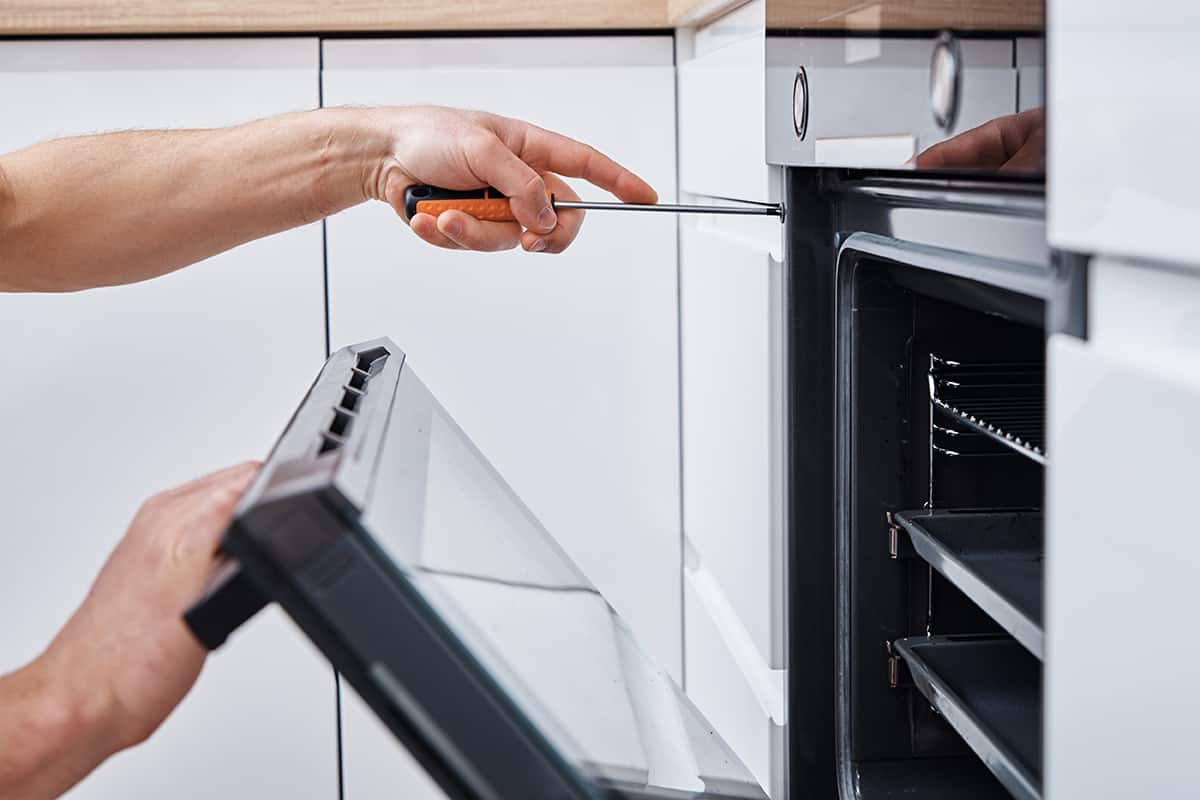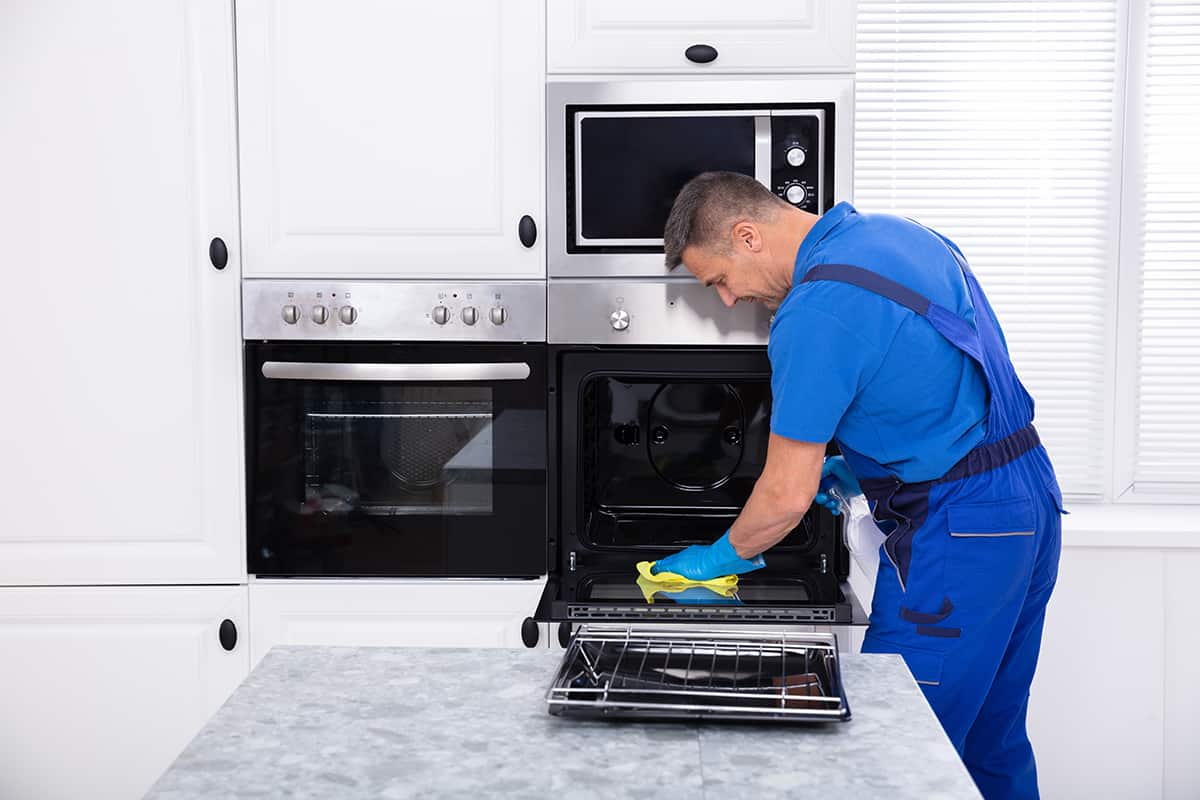So, you’re about to bake your signature apple pie, and just as you’re about to pop it into the oven, you notice something odd. The oven light, that trusty little bulb that lets you peek at your culinary masterpieces without opening the door, is blinking. Is it Morse code, or is there something more sinister going on?
The blinking of an oven light can be attributed to various factors, often involving electrical discrepancies or component malfunctions. Addressing the issue may entail examining internal wirings, the door switch, or other related components.
This guide will further highlight these common causes and offer practical fixes. By the end, you should have your oven up and running in no time!
What Does an Oven Light Do?

The oven light is that little beacon inside your oven, letting you peek at the magic happening inside without disturbing the process.
Every time you open the oven door, you let out heat. The oven light lets you check on your food’s progress, ensuring your cookies don’t morph into charcoal without opening the door and affecting the temperature.
In addition, ovens take time to heat up. If you’re constantly opening the door to check on your dish, it cools down a tad and has to reheat. That light keeps you from playing this hot-cold game, saving both energy and cooking time.
Common Causes of Oven Light Blinking
A blinking oven light is like a disco party you never asked for. Before you attempt a DIY seance or call in the oven exorcists, let’s get a grip on what might be causing this.
1. Electrical Issues
You don’t need to be an electrician to understand this. A stray wire can render the entire operation useless.
- Faulty Wiring: Just like our old phone chargers wiggle out of action, oven wires can lose their mojo. Over time, they can get frayed, disconnected, or damaged.
- Power Surges: Have you ever had your lights flicker during a storm? That’s a power surge. If your oven was on or plugged in during one of these, it might have gotten a little “shocked.”
- Circuit Overload: When too many appliances are on the same circuit, it can overload. This might cause your oven light to blink or even dim.
2. Control Board Malfunctions
The control board can become overwhelmed after nonstop baking sessions. This little genius controls the oven’s temperature, timer, and yes, the light. If it’s acting up, it might send the wrong signals. If your oven light’s blinking, but you’re also seeing weird temperature readings or timer issues, the control board might be the culprit.
3. Door Switch Problems
Your oven door has a little switch that’s like a mini doorman. When things are in order, he keeps the light on. But if there’s a problem, he might just switch it on and off. This switch turns the light on when you open the door and off when you close it. If the light blinks when you open or close the door, or if it doesn’t come on at all, the switch might be on a break.
4. Bulb Issues
Not all heroes wear capes. Some just glow, but bulbs have their off days too. Bulbs don’t last forever. On average, they last around 20,000 hours. But sometimes, they can retire early. If your bulb’s flickering or dimming, it might be singing its swan song.
5. Sensor Failures
Your oven has sensors that are like its sixth sense. They keep things in check. But sometimes, they can get a little wonky.
- The purpose of oven temperature sensors is to monitor and regulate the oven’s heat. If they detect something’s off, they’ll communicate, sometimes through the light.
- Detecting a Sensor Malfunction: If your food’s either coming out charred or half-baked, and you’ve got a blinking light, the sensors might be shouting for help.
Fixes for a Blinking Oven Light

Don’t let a blinking light spoil your cooking vibe. Here’s your recipe to fix that rogue light and get back to baking in peace.
1. DIY Solutions
Roll up those sleeves, and let’s dive into some do-it-yourself magic! With the right steps, you can be the oven whisperer your kitchen needs. Before you start any oven shenanigans, always disconnect the power. No one wants a shocking experience, right?
- Quick Fixes: Give your oven a little reset. For example, when our phones act up and we restart them, sometimes ovens just need a break. Unplug it, wait a bit, then plug it back in.
- Checking and Replacing the Bulb: If the light is dim or flickering, it might be time for a bulb swap. Unscrew the old one, grab a new oven-specific bulb, and screw it in. Voilà!
- Examining the Door Switch: Remember our mini doorman? If he’s acting up, a quick inspection will help. Locate the switch, press it a few times, and see if it feels loose or sticky.
2. Professional Interventions
Sometimes, an oven throws curveballs that are out of our league. That’s when we call in the big guns: the pros.
- When to Call a Technician: If you’ve tried the DIY route with no luck or if you suspect bigger issues (like that control board brain thing), it might be time to ring a repair service.
- Cost Estimates for Common Repairs: Oven repairs can range from $50 for minor issues to over $300 for major ones. Always get a quote beforehand so you’re not caught off-guard.
Maintenance Tips to Prevent Future Issues

We all love it when our ovens work like a charm, ready to help us whip up those culinary delights. But much like cars or anything mechanical, ovens need some love and care, too.
1. Routine Cleaning
First things first —cleanliness is next to oven godliness. It’s not just about removing those burnt cheese remnants from your last epic pizza night.
- Inside the Oven: Use a mild cleaner, and avoid anything too abrasive. Gentle scrubs can help prevent build-up of food particles that can mess with your oven’s performance.
- The Oven Glass Door: Keep it sparkling. It’s not just for Instagram-worthy food pics; it helps you keep an eye on your food without opening the door and lets you spot any potential issues early.
- The Racks: Slide them out, give them a wash. Clean racks mean better air circulation and more even cooking.
2. Keeping Electrical Connections Intact
The electrical connections make sure your baking excursions go on without a hitch!
- Check the Plug and Cable: Look for fraying, damage, or any signs of wear. It’s like checking your phone charger cable, but you know, bigger.
- Examine the Fuse: If it’s blown, it’s not going to light up your life (or your oven) anytime soon. Replacements are as easy as popping to the store or ordering online.
3. Regularly Inspecting the Oven’s Components
Getting up close and personal with your oven’s bits and bobs can help spot little issues before they turn into costly repairs.
- Door Seals: These keep the heat in. If they’re damaged, your oven’s efficiency drops faster than a soufflé in a draft. A quick visual check during cleaning can catch this early.
- Light Housing: Keep it clean, and it’ll be easier to tell if the light’s acting up because it’s dirty or if there’s another issue at play.
- Knobs and Buttons: They should be responsive and easy to turn or press. Sticky or non-responsive controls can indicate underlying issues.
4. Ventilation Check
A well-ventilated oven is a happy oven. It breathes easier, works better, and stays cooler.
- Check the Vent Openings: Make sure they’re not blocked or dirty. A quick vacuum or wipe can do wonders.
- Examine the Exhaust System: If your oven is vented, make sure the exhaust paths are clear and clean.






